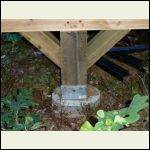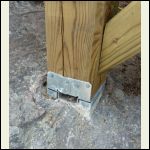|
| Author |
Message |
merlinmaine
Member
|
# Posted: 5 Sep 2013 09:40pm
Reply
24'x24' cabin going up in coastal Maine. It's looking like bedrock is about 3 1/2 ft down. We're considering going with "severe service"
.60 pressure treated 6x6's right directly on the bedrock. Backfilled with copious gravel for drainage. Looking for thoughts, opinions and best practices. Access and water are very difficult for any concrete work..that's why we're considering going direct with the 6x6's
Thanks !!!
|
|
burtonridr
Member
|
# Posted: 6 Sep 2013 02:44pm - Edited by: burtonridr
Reply
I'm in your same situation. I plan to drill into the bed rock, then use anchor bolts in the bed rock. Then concrete cast a small 8x8 footing around the anchor bolt. The anchor bolt will go all the way through the poured footing out the top to center my posts on top of. The house will be elevated up in the air on post and beams.
See pic
|
|
merlinmaine
Member
|
# Posted: 6 Sep 2013 04:15pm
Reply
We're actually thinking of skipping the footing, what's more solid and stable than bedrock, pin the post right to the bedrock, backfill with lots of gravel.
We figure ground water runs through the soil to the bedrock and then drains away down slope, so the posts should stay very dry.
|
|
burtonridr
Member
|
# Posted: 6 Sep 2013 06:26pm - Edited by: burtonridr
Reply
I wasnt recommending a footing wall, my drawing is just a pier footing(8x8x6 or something)... basically just a flat surface for the post to sit. I have a steep slope so I wouldnt trust my posts sitting directly on the bed rock, I need something to create a level surface. Heck I suppose one could chip out a small flat surface in the bedrock and sink an anchor bolt. If you are on flat(level) bedrock then you probably dont need to pour anything. But you need a flat surface for the post to sit, the sheer action of the post wanting to slide down hill could tear the beam apart at the anchor bolt.
There are a bunch of ways someone could do what we are discussing.
Obviously in both situations we would use treated wood or some type of vapor barrier to protect the post.
P.S. I just was reading a different thread, if you havent heard of ecobust, check it out. The stuff breaks apart boulders/ concrete, its sold as a cheap option to dynamite. They sell it at home depot. I will probably need it to bust up some of the bedrock for a few projects.
|
|
ShabinNo5
Member
|
# Posted: 7 Sep 2013 08:45am
Reply
merlinmaine,
We built in Northern Minnesota where the Bedrock is at the surface or just a few feet under what soil exists. The Shabin is 10 X 20 with a six foot deck wrapping around three sides. The entire structure is built on 18 posts. We cleared all of the loose soil and rock away for each pier and found that a few of the locations were very wet. While you are correct in that the water will flow along the bedrock, the assumption that the soil will stay dry may not hold true.
Addtionally, our location was not easy to work with. All materials have to be carried down a path a few hundred feet. We poured concrete piers using 10" sono tubes (three pins were drilled into the bedrock for each pier, 18" above and below). This was the one area where we used equipment. A mini escavator was driven down the path a few times to deliver rock, sand and concrete bags. I carried three five gallon water jugs separately (numerous times). All of the concrete was mixed by hand and the pour was complete in one day.
Personally I have more confidence in the durability of concrete than treated wood when buried in soil.
Also I would not worry about the additional effort. Think of it as a warmup or training for hauling the rest of the materials for building the 24 X 24 structure 
|
|
Truecabin
Member
|
# Posted: 7 Sep 2013 02:42pm
Reply
burtons pic is good. one bag of concrete to level out each rock will help it to not settle over the years and can raise the post a few inches then there is drain rock below the post end. try to use the treated post end down dont put a fresh cut end down in the hole. You can toenail lag screws in at angles then pot them into the concrete that will hold better than straight into the endgrain. dig some holes now and pour water in to see if it drains
|
|
Ontario lakeside
Member
|
# Posted: 7 Sep 2013 11:23pm - Edited by: Ontario lakeside
Reply
We installed 16 piers on bedrock. All but 4 were on the exposed surface rock. The rest were about 6" - 18" below grade. For those we drilled a 3/4" hole 6" deep and anchored a 5/8" threaded rod. Then we poured a 10" sono tube to 6" above grade.
The 6x6 were bolted to that with a simpsons strong tie.
Our building inspector would not allow any wood in contact with soil.
All the concrete was brought in by boat and hauled up a 30 degree incline 200' from the water.
I think the extra effort was worth it. Your going to haul gravel might as well haul concrete.
Screen_shot_201309.png
| 
Screen_shot_201309.png
|  |  |
|
|
|

